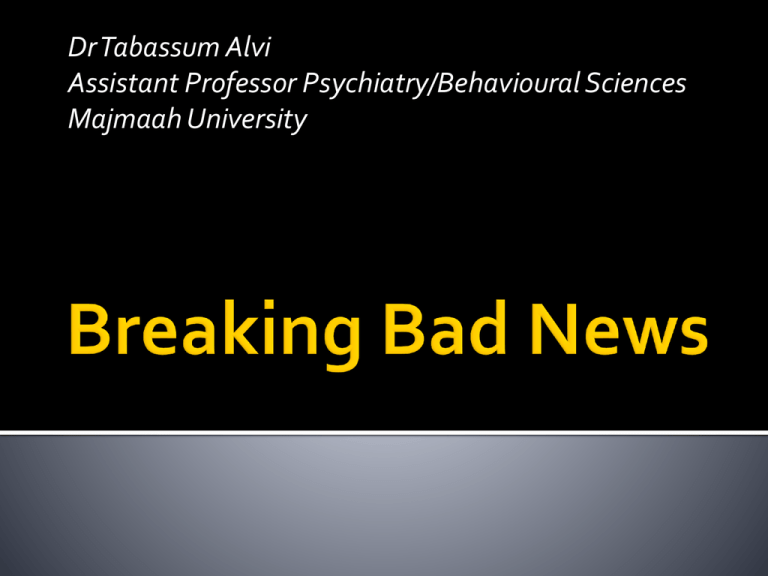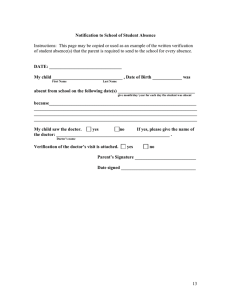breaking bad news
advertisement

DrTabassum Alvi Assistant Professor Psychiatry/Behavioural Sciences Majmaah University Use appropriate strategies to breaking bad news ‘Any news that adversely and seriously affects an individual’s view of his or her own future is considered as bed news’ Doctors don’t know how to do it. They don’t want to be honest. They protect patient. They don’t have time 1) 2) Information given according to needs of person. Cultural myth that we want to protect patient should be avoided. Disclosing the diagnosis of cancer. Discussing cancer recurrence or failure of treatment. Disclosing meta static disease. Discussing the presence of irreversible disease or serious treatment toxicity. Disclosing positive results of genetic tests. Announcing the death. This model involves giving full information to every patient as soon as it is known. Assumptions Patient has right to receive full information about self. Doctor has obligation to provide information. All patients want to know bad news about them. Patient should decide what treatment is best for them. Advantages Promotes doctor-patient trust. Enhance family support. Allowing time to put affairs in order. Helpful for those who cope by finding out maximum information. Disadvantage Discussion of options in detail may frighten and confuse some patients. Insisting on information may undermine defenses. Lastly full information may have negative emotional consequences for some patients. This view states that under no circumstance should patients be informed that they have acquired a lethal disease. It is based on the principle that the patient needs protection from the terrible reality of terminal illness. Assumptions It is appropriate for doctor to decide what is best for the patient. Patients do not want to hear bad news about them. The patients need to be protected from bad news. Advantages It is easier Less time consuming Suits those people who prefer not to know their condition. Disadvantage Denial of opportunity to adjust. Trust in doctor is undermined. Opportunity for helpful intervention are lost. Patient compliance is less likely. Disadvantage Patients may acquire wrong information that can lead to avoidance, isolation and a perception of rejection. There are chances that patient loses sense of control. In this model the amount of information disclosed and the rate of its disclosure are tailored to the desires of the individual patient by doctor-patient negotiation. Assumptions It has the capacity to maximize quality of life for the patient. People are different; it takes time to absorb and adjust to bad news. Partnership relationship is basis for decision making in patient's best interest. Advantages Needs of the individual is addressed. Supportive and trusting relationship with the doctor is established Disadvantages It is a time consuming process. It drains caregivers' emotional resources. This model implies that information about the patient’s disease is the right of the doctor and he delivers the information in a ‘sugar coating’ to minimize the pain and distress of the patient. It is not a recommended method any more. This model is a modification of model 3. It is a comprehensive addressing of all the aspects of informational care, and principles of effective communication and counseling To decrease uncertainty To complete left over work Needs management Prepare for grief Advance direction Enhance mutual support by family Accidental finding will damage doctor- patient relationship Other sources can mislead him Be honest Be warm Be aware of religious & cultural values Use basic counseling skills Serve as a series of continuous support & encouragement as long as possible Encourage questions & legitimate hope that a full valuable life can still be lived. Prepared to receive patients anger. Prepared to have professional competence challenged. Prepared not to have all answers. Senior doctor, fully trained in art of communication. As soon as diagnosis is certain Introduce yourself Introduction of subject Straight forward way Feel concerned with patient Use familiar language & simple words Indicate facts Give time for questions Following disclosure patient should be given private place & time to be with relatives. Give few minutes alone to patient to express his feelings freely Soften bad news with good new Patient are appreciative of any information that provides hope (no falsified hope) Avoid technical jargon Don’t try to give precise prognosis Make sure of next appointment arrangement within 24-48 hours Continue dialogue Instill hope i.e. full & valuable remaining life is possible Encourage patient to talk about meaning of illness and life If patient has fail to ask greater details involve him in decision making. Mobilize coping mechanism Frequent short interviews Provide information to make intelligent decision about own treatment. Ask patient to write down questions Do make an offer to introduce the patient to another patient with similar condition Provide leaflets or written information Explanation should be clear & not only technical Exclusivity Involvement of significant others Seating arrangements Appear attentive and calm Listening mode Availability The principle involved in this step is “before you tell, ask". What does he or she thinks about his medical condition. Example 1) What did you think was going on with you when you felt lump? 2) What have doctors told you about all this so far? Note the language and vocabulary of the patient. If the patient is in denial, try not to confront him in the first interview. Most patients want to know all about their illness but assumption towards that should be avoided. Obtaining overt permission respects the patient’s right to know or not to know. Would you like me to give you details about what is going on ? or Would you prefer I tell you about the treatment I am prescribing to you? Before you break bad news, give your patient a warning to prepare him. Use same language as it maintain a therapeutic relationship with the patient. Avoid scientific and technical language. Give information in small bits and clarify whether he understands Emotions and reactions arise during the interview, acknowledge them and respond to them. It comprise of 3 components. 1) One needs to listen and identify the emotion and acknowledge them. 2) Identify the source of that particular emotion. 3) Respond by showing that you understand the emotional expression of the patient. Recapitulate the information of all that has been discussed and give your patient an opportunity to voice any major concerns or questions. Clear plan for the next steps that need to be taken regarding management of the issues.




